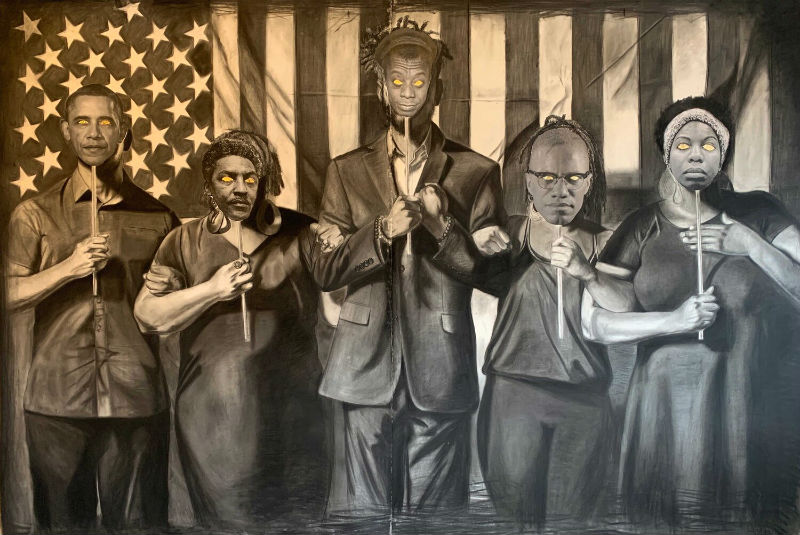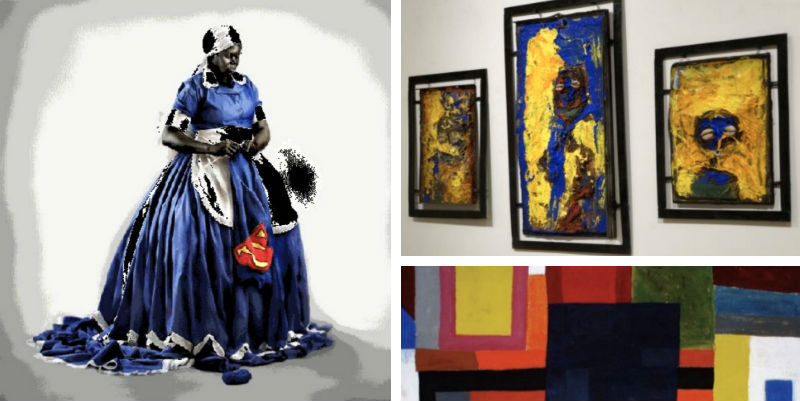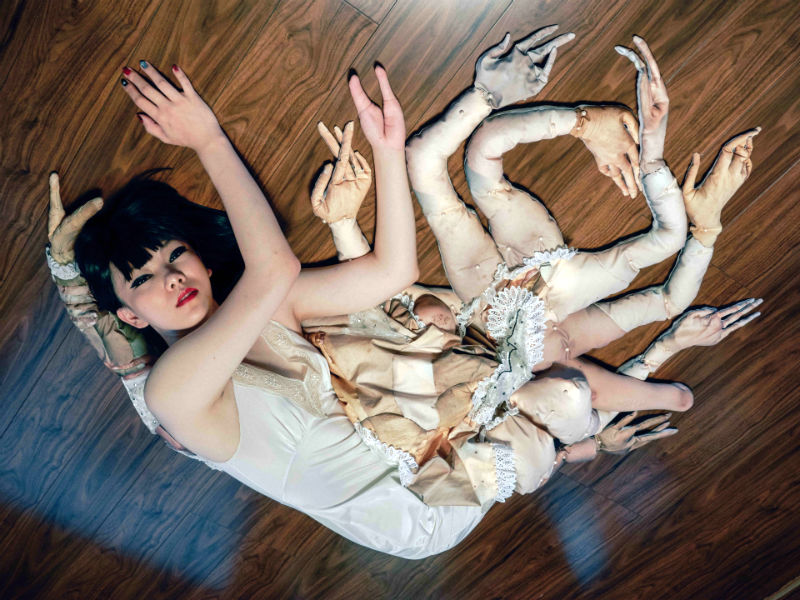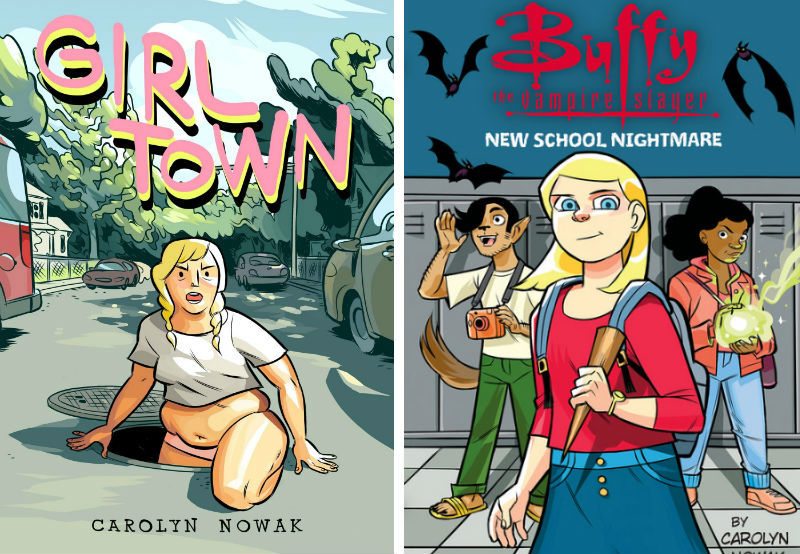AADL 2019 STAFF PICKS: BOOKS, MUSIC, MOVIES & MORE

AADL 2019 STAFF PICKS: BOOKS, MUSIC, MOVIES & MORE
Below you will see that 41 Ann Arbor District Library employees composed 18,000 words listing arts and culture that made an impact on their lives in this calendar year. While movies, books, and music released in 2019 figured prominently among our picks, we never limit our selections to material from the past year. Not all timeless art can be discovered and absorbed in a mere 365 days, so we're like Master P: no limits.
Melting Into Darkness: "A World Without Ice" at Ann Arbor Hands-On Museum

"It's making me uncomfortable but it's relaxing, too."
My kid's succinct review of A World Without Ice at Ann Arbor Hands-On Museum likely captures the sensation U-M music professors Michael Gould and Stephen Rush, along with Dutch electronic-media artist Marion Tränkle, had in mind when they created their multimedia installation with climate scientist and U-M professor emeritus Henry Pollack (co-recipient of the 2007 Nobel Peace Prize with Al Gore).
Pollack's book A World Without Ice inspired the exhibit, which artfully illustrates through sound, music, and visuals the glaciers melting and asks us to consider our role in their disappearance.
Rush created a dark, ambient composition that drones discretely in the background as Tränkle's film -- featuring Pollack and associate's gorgeous images of the Arctic and Antarctic -- plays on a curved screen. But as you sit in the blackened room and your ears tune-in to Rush's music, the soothing and menacing tones are punctuated by the seven floor-tom drums arced around the front of the exhibit. (Presumably, seven toms for the seven continents, all of which will be affected by climate change.)
UMMA's "Reflections: An Ordinary Day" explores quotidian moments in Inuit life

What one person might consider an ordinary, everyday scene, another might see as unusual and unique. It all depends on where you live, since cultures evolve in different ways that fit their environments. So, a person from the Caribbean might not recognize something from the Arctic as commonplace and vice versa.
Reflections: An Ordinary Day, an exhibit University of Michigan Museum of Art (UMMA) that features Inuit art, is filled with imagery of everyday tasks and mythologies of people who live in the Far North. But for people who live in the Midwest, these representations are anything but banal or commonplace.
This is the UMMA’s second exhibit of Inuit art and it gives viewers a chance to see even more works gifted by the Power family to the museum. In the newly named Eleanor Noyes Crumpacker Gallery, prints, drawings, and sculptures spanning from the mid-1950s to the 2010s are now on view through May 10, 2020.
The first exhibit, The Power Family Program for Inuit Art: Tillirnanngittuq, focused on the history of the Power family’s collecting and promoting art in the Cape Dorset area. While many of the pieces on display in Reflections: An Ordinary Day are direct promised gifts from the Power Family, others are purchases made possible by the Power Family Program, or gifts by donors such as Katherine Kurtz and Raburn Howland.
Works in the gallery span from the mid-20th century to the early 21st-century and feature Inuit artistic methods of inscription, printmaking, carving, and drawing. UMMA curator Vera Grant notes that the images selected for the exhibition are united in their depictions of “seemingly ordinary” everyday imagery.
Inspiration, Aspiration, Expertise: “Gerome Kamrowski: Ann Arbor’s Own Surrealist” at The Michigan Art Gallery

Gerome Kamrowski in his backyard with his sculptures; first published in black and white in The Ann Arbor News, September 4, 1993. Photo by Photographer: D. A. Biermann.
I only met Gerome Kamrowski once. He granted The Ann Arbor News a 1993 interview for the paper’s annual old school “M-Edition,” a special start-of-the-school-year section.
We met at Kamrowski's tree-lined Waterhill residence where he had a detached studio. The place looked like a well-organized bead foundry -- only in this instance, the place had also been overrun by a menagerie of fantastic creatures.
Even at the age of 79, Kamrowski had the muscular heft of a lumberjack -- a handshake that griped like an iron vice -- and the soft-spoken grace of an artiste as he played with the rows of colorful beads he used to craft his late series of eccentric, surreal sculpture.
But Kamrowski's hypnagogic style wasn't a recent turn; he started to develop it 50 years prior when he lived in New York City.
During the winter of 1939/40, artful youths Kamrowski, William Baziotes (known to art historians), and Jackson Polack (known to the rest of us) were, in Kamrowski’s words, “fooling around” with lacquer paint in studio when they began throwing paint on canvases using a palette knife and a slashing gesture; ultimately overlaying paint upon layer of hard drying and smooth surface paint to create a muscular variation of French surrealist André Masson’s automatic drawing.
Borrowing a cliché that has stood the test of time: The rest was history.
Well, sort of …
Paper Tiger: Ann Arbor artist Matthew Shlian offers a new work via Ghostly and a retrospective book

I'm not a clumsy person -- in fact, I'm kinda athletic.
But I have the spatial awareness of a toddler.
I often have a hard time visualizing how something is created if I'm trying to replicate that thing from written instructions, a diagram, or a video. My brain doesn't translate the info in a way that my fumbling hands can follow.
Matthew Shlian's superpower is spatial awareness.
The Ann Arbor-based artist has the remarkable ability to build stunning 3D paper sculptures that undulate, pop, jab, and ripple. He creates his art by gluing together small pieces of paper and then affixing them in patterns that create the illusion of movement. Shlian's deep understanding of spatial relationships and shading allows him to create complex patterns that still seem minimalist.
Since 2011, Shlian has distributed many of his limited edition works through Ghostly International, which is best known for releasing electronic music but it's also had many partnerships with artists and companies to create branded pieces that run from shoes to a custom video-game console, as well as unbranded fine art from Andy Gilmore, Brandon Locher, and Langdon Graves.
Omoplata is Shlian's latest series promoted by Ghostly, and despite the artworks' delicate look, the design was inspired by a tricky submission move in Brazilian jiu-jitsu:
This Is America: Tylonn J. Sawyer's "WHITE HISTORY MONTH VOL. 1" at LSA Humanities Gallery

Tylonn J. Sawyer's exhibition WHITE HISTORY MONTH VOL. 1 might not seem to be made for people who ask, “Why don’t we have a White History Month when we have Black History Month?”
But people who ask that question should see this exhibit at the LSA Humanities Gallery at the University of Michigan.
Sawyer is an artist, educator, curator, and activist based in Detroit who tackles difficult questions of race and identity in American culture. He grapples with the "why don't we have" question by representing iconic African-Americans in his show devoted to “white history” by suggesting that white history is inextricably linked to black history in the U.S. He uses varied media in his explorations of identity and race, including drawings on paper, oil paintings, a soundtrack, and a short film.
His works at LSA range from monumental drawings to intimate portraits of influential black women artists. Sawyer disrupts typical histories of the Civil War and its monuments in these bodies of work by referencing the creation and destruction of monuments both in America and throughout known history. He also offers audiences new heroes through Grâce Noire, his series of charcoal and glitter portraits of black women artists, including Faith Ringgold, Kara Walker, Sydney G. James, and Tiff Massey, an interdisciplinary artist based in Detroit.
Interactive Empathy: "Way Opens (Disability Arts and Culture)" at Riverside Arts Center

In its juried exhibition Way Opens (Disability Arts and Culture), Riverside Arts Center asks, “What does ‘disabled’ mean to such a broad range of people who identify as such?”
Works in the show certainly address artists’ personal experiences with disability, but also offer opportunities for audiences to explore what this means interactively, ideally working toward empathy and interrogation into internalized perceptions of disability. Artists in the show grapple with questions of identity and disability, mostly in America, through multimedia installations, interactive exhibits, painting, fiber arts, video, sculpture, and written word.
The Riverside Arts Center gallery space included multiple changes to the layout typically used for a group exhibition. The center space, instead of being open, or containing installations that require physical engagement, contained tables and chairs to allow visitors to sit and enjoy the show from many positions. The gallery’s book of artist statements is printed in large type and, in addition to the usual statements and bios, includes detailed descriptions of each exhibit for visually impaired visitors.
Never Forget: Rachel Willis' exhibit at GalleryDAAS memorializes slavery in Detroit and Martinique

The University of Michigan Department of Afroamerican and African Studies' GalleryDAAS is hosting a multi-media collaborative exhibit by artist and scholar Rachel Willis, titled Il faut se souvenir, we must not forget: Memorializing Slavery in Detroit and Martinique. It combines Willis’ background in fine arts, history, and Francophone studies to bring the under-told history of slavery in Detroit and Martinique.
Willis was raised in Detroit and received a Bachelor of Arts in French & Francophone Studies from the University of Michigan. In her current work, Willis employs a multi-disciplinary approach to her subject matter, using photographs, historical texts, and technology to explore the history of Detroit’s ties to slavery and the French Caribbean Island of Martinique. Willis is currently working on a Master of Arts in Transcultural Studies, with a focus on Francophone and Caribbean history. Her passion to make little-known yet highly important histories accessible through gallery text and voice tour, paired with photography, creates both a challenging and dynamic experience in GalleryDAAS.
The Body Politic: Japanese artist Mari Katayama challenges attitudes toward the differently abled in her debut U.S. solo show

The first solo show in the United States for Japanese artist Mari Katayama is right here in Ann Arbor.
Katayama’s works are on display at the University of Michigan Museum of Art in the Irving Stenn Jr. Family Gallery through January 26, 2020. Her creations include both photographs and sculptures that disrupt normative viewing of the body, which weave a narrative that rejects dominant cultural and societal attitudes toward disabled bodies. Katayama not only uses her own body as a subject, but she also incorporates surrealist, complex, and skillful handmade prosthetics from textiles and other materials. Her works explore concepts of the self, the body and objectification, voyeurism, and agency.
Turn and Face the Strange: Cartoonist Casey Nowak's big life changes have invigorated her art

The two years since Casey Nowak last answered questions for Pulp have been filled with personal changes and critical success. Followers of Nowak’s on Twitter may also have noticed her using the platform to discuss her own experiences with sexuality, divorce, mental health, and recently a series of tweets discussing her name change from Carolyn to Casey.
The Ann Arbor cartoonist feels these experiences, both good and bad, have influenced and increased her confidence in her work.
In late 2018, Top Shelf released Nowak’s collection of short stories, Girl Town. These previously released stories, along with one unpublished work, secured Nowak some of her best critical reactions to date. Girl Town finished the year on numerous “Best of” lists, was nominated for an Eisner Award (akin to comics' Academy Award), and last month won Nowak her third Ignatz Award, which recognizes excellence among self-published or small-press creators.
Previously, Nowak had an acclaimed 12-issue run as the artist for the popular series Lumberjanes, and in 2017 she published Chad Agamemnon, an all-original comic for the Ann Arbor District Library's annual Ann Arbor Comic Arts Festival (A2CAF). (AADL cardholders can download the comic here.)
Nowak has also released the first two volumes of her middle-grade Buffy the Vampire Slayer series and ventured into erotic comics with the release of No Better Words, which also scored an Eisner nomination for the cartoonist. Earlier this year, Nowak started a Patreon site, which allows fans to subscribe at various tiers to gain access to exclusive content from Nowak including works in progress and exclusive mini-comics like last month’s Duh! Ha-Ha!
Nowak was kind enough to answer a few emailed questions for Pulp.


































